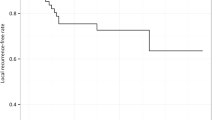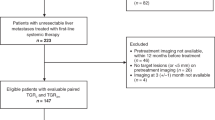Abstract
Background
The treatment modalities for uveal melanoma (UM) include surgery and radiotherapy (RT). The utilization of RT as a strategy for organ preservation has been increasing, but the survival difference between the two aforementioned treatment modalities has not been reported.
Methods
An observational and cohort study was performed using a propensity score with an already existing public database. Patients diagnosed with UM within the period from 2004–2013 were selected from the Surveillance, Epidemiology, and End Results (SEER) database. One-to-one matching and inverse probability of treatment weighting (IPTW) using the propensity score were used to estimate and compare survival rates.
Results
Overall, 3291 patients were treated: 2503 received RT only (RT group) and 788 received surgical resection only (surgery group). The RT group had an improved crude 5‑year overall survival (OS) rate compared with the surgery group (76% vs. 60%, P < 0.001), and an improved 5‑year melanoma-specific survival (MSS) rate (89% vs. 73%, P < 0.001). Compared to the surgery group, the RT group was associated with improved OS (hazard ratio [HR] 0.52, 95% confidence interval [CI] 0.38–0.73, P < 0.001) and MSS (HR 0.48, 95% CI 0.35–0.65, P < 0.001) in the matched cohort. The survival benefit of the RT group maintained after adjustment with IPTW, both in OS and MSS.
Conclusions
To our knowledge, the present study was the first to demonstrate the survival difference between the two treatment modalities for UM using both the propensity score matching and weighting methods with the SEER database. The current study suggests that RT may provide a survival advantage over surgery in the treatment of UM.
Zusammenfassung
Hintergrund
Die Behandlungsmodalitäten für das Uveamelanom (UM) sind die Chirurgie und Strahlentherapie (RT). Die Nutzung der RT als Strategie zum Organerhalt hat zugenommen, aber der Unterschied in der Überlebensrate zwischen den beiden zuvor genannten Behandlungsmodalitäten wurde nicht berichtet.
Methoden
Beobachtungs- und Kohortenstudie unter Verwendung eines Propensity-Scores mit einer bereits vorhandenen öffentlichen Datenbank. Patienten, bei denen im Zeitraum von 2004 bis 2013 ein UM diagnostiziert worden war, wurden aus der Datenbank Surveillance, Epidemiology, and End Results (SEER) ausgewählt. Eins-zu-eins-Matching und inverse Behandlungswahrscheinlichkeitsgewichtung (IPTW) unter Heranziehung des Propensity-Scores wurden angewendet, um die Überlebensraten abzuschätzen und zu vergleichen.
Ergebnisse
Insgesamt wurden 3291 Patienten behandelt: 2503 erhielten nur eine RT (RT-Gruppe) und 788 erhielten nur eine chirurgische Resektion (Chirurgiegruppe). Die RT-Gruppe hatte im Vergleich zur Chirurgiegruppe eine verbesserte 5‑Jahres-Gesamtüberlebensrate (OS; 76 % vs. 60 %, P < 0,001) und eine verbesserte melanomspezifische 5‑Jahres-Überlebensrate (MSS; 89 % vs. 73 %, P < 0,001). Im Vergleich zur Chirurgiegruppe war die RT-Gruppe mit einem verbesserten OS (Hazard Ratio [HR] 0,52, 95 %-Konfidenzintervall [KI] 0,38–0,73, P < 0,001 und MSS [HR 0,48, 95 %-KI 0,35–0,65, P < 0,001]) in der gematchten Kohorte assoziiert. Der Überlebensvorteil der RT-Gruppe blieb nach der Anpassung mit IPTW erhalten, sowohl im OS als auch im MSS.
Schlussfolgerungen
Nach unserer Kenntnis war die vorliegende Studie die erste, die den Überlebensunterschied zwischen den beiden Behandlungsmodalitäten für UM unter Verwendung sowohl des Propensity-Score-Matchings als auch der Gewichtungsmethoden mit der SEER-Datenbank demonstrierte. Die aktuelle Studie deutet darauf hin, dass die RT einen Überlebensvorteil gegenüber der Operation in der Behandlung von UM bieten kann.


Similar content being viewed by others
References
Singh AD, Turell ME, Topham AK (2011) Uveal melanoma: Trends in incidence, treatment, and survival. Ophthalmology 118:1881–1885
Nathan P, Cohen V, Coupland S et al (2015) Uveal Melanoma UK National Guidelines. Eur J Cancer 51:2404–2412
Simpson ER, Gallie B, Laperrierre N et al (2014) The American Brachytherapy Society consensus guidelines for plaque brachytherapy of uveal melanoma and retinoblastoma. Brachytherapy 13:1–14
Group COMS (2006) The COMS randomized trial of iodine 125 brachytherapy for choroidal melanoma: V. Twelve-year mortality rates and prognostic factors: COMS report No. 28. Archives of ophthalmology (Chicago, Ill.: 1960) 124: 1684
Damato B (2007) Legacy of the collaborative ocular melanoma study. Arch Ophthalmol 125:966–968
Seddon JM, Gragoudas ES, Albert DM et al (1985) Comparison of survival rates for patients with uveal melanoma after treatment with proton beam irradiation or enucleation. Am J Ophthalmol 99:282–290
Caujolle J‑P, Mammar H, Chamorey E et al (2010) Proton beam radiotherapy for uveal melanomas at nice teaching hospital: 16 years’ experience. Int J Radiat Oncol Biol Phys 78:98–103
Dunavoelgyi R, Dieckmann K, Gleiss A et al (2011) Local tumor control, visual acuity, and survival after hypofractionated stereotactic photon radiotherapy of choroidal melanoma in 212 patients treated between 1997 and 2007. Int J Radiat Oncol Biol Phys 81:199–205
Egger E, Schalenbourg A, Zografos L et al (2001) Maximizing local tumor control and survival after proton beam radiotherapy of uveal melanoma. Int J Radiat Oncol Biol Phys 51:138–147
Sarici AM, Pazarli H (2013) Gamma-knife-based stereotactic radiosurgery for medium- and large-sized posterior uveal melanoma. Graefes Arch Clin Exp Ophthalmol 251:285–294
Austin PC (2011) An introduction to propensity score methods for reducing the effects of confounding in observational studies. Multivariate Behav Res 46:399–424
Austin PC, Stuart EA (2015) Moving towards best practice when using inverse probability of treatment weighting (IPTW) using the propensity score to estimate causal treatment effects in observational studies. Stat Med 34:3661–3679
Imbens GW (2004) Nonparametric estimation of average treatment effects under exogeneity: A review. Rev Econ Stat 86:4–29
Austin PC (2009) Using the standardized difference to compare the prevalence of a binary variable between two groups in observational research. Commun Stat Comput 38:1228–1234
Affeldt JC, Minckler DS, Azen SP et al (1980) Prognosis in uveal melanoma with extrascleral extension. Arch Ophthalmol 98:1975–1979
Kleineidam M, Guthoff R, Bentzen SM (1993) Rates of local control, metastasis, and overall survival in patients with posterior uveal melanomas treated with ruthenium-106 plaques. Radiother Oncol 28:148–156
Schmittel A, Bechrakis NE, Martus P et al (2004) Independent prognostic factors for distant metastases and survival in patients with primary uveal melanoma. Eur J Cancer 40:2389–2395
Sandinha MT, Farquharson MA, McKay IC et al (2005) Monosomy 3 predicts death but not time until death in choroidal melanoma. Invest Ophthalmol Vis Sci 46:3497–3501
Shields CL, Kaliki S, Furuta M et al (2013) American Joint Committee on Cancer classification of posterior uveal melanoma (tumor size category) predicts prognosis in 7731 patients. Ophthalmology 120:2066–2071
Abrams MJ, Gagne NL, Melhus CS et al (2016) Brachytherapy vs. external beam radiotherapy for choroidal melanoma: Survival and patterns-of-care analyses. Brachytherapy 15:216–223
McLean IW, Foster WD, Zimmerman LE et al (1983) Modifications of Callender’s classification of uveal melanoma at the Armed Forces Institute of Pathology. Am J Ophthalmol 96:502–509
Singh A, Shields C, Shields J (2001) Prognostic factors in uveal melanoma. Melanoma Res 11:255–263
Kapoor A, Beniwal V, Beniwal S et al (2016) Management of uveal tract melanoma: A comprehensive review. J Egypt Natl Canc Inst 28:65–72
Gragoudas ES, Egan KM, Seddon JM et al (1991) Survival of Patents with Metastases from Uveal Melanoma. Ophthalmology 98:383–390
Zimmerman LE, McLean I, Foster WD (1978) Does enucleation of the eye containing a malignant melanoma prevent or accelerate the dissemination of tumour cells. Br J Ophthalmol 62:420–425
Gragoudas E, Li W, Goitein M et al (2002) Evidence-based estimates of outcome in patients irradiated for intraocular melanoma. Arch Ophthalmol 120:1665–1671
Wang Z, Nabhan M, Schild SE et al (2013) Charged particle radiation therapy for uveal melanoma: a systematic review and meta-analysis. Int J Radiat Oncol Biol Phys 86:18–26
Author information
Authors and Affiliations
Corresponding author
Ethics declarations
Conflict of interest
B.-S. Jang, J.H. Chang, S. Oh, Y.J. Lim and I.H. Kim declare that they have no competing interests.
Ethical standards
All procedures performed in studies involving human participants were in accordance with the ethical standards of the institutional and/or national research committee and with the 1964 Helsinki declaration and its later amendments or comparable ethical standards. For this type of study formal consent is not required.
Caption Electronic Supplementary Material
66_2017_1203_MOESM3_ESM.tif
Supplementary Fig. 2 Overall survival of radiotherapy vs. surgery classified by T stage in the matched cohort and in the weighted cohort
66_2017_1203_MOESM4_ESM.tif
Supplementary Fig. 3 Melanoma-specific survival of radiotherapy vs. surgery classified by stage in the matched cohort and weighted cohort
Rights and permissions
About this article
Cite this article
Jang, BS., Chang, J.H., Oh, S. et al. Surgery vs. radiotherapy in patients with uveal melanoma. Strahlenther Onkol 193, 931–942 (2017). https://doi.org/10.1007/s00066-017-1203-0
Received:
Accepted:
Published:
Issue Date:
DOI: https://doi.org/10.1007/s00066-017-1203-0




